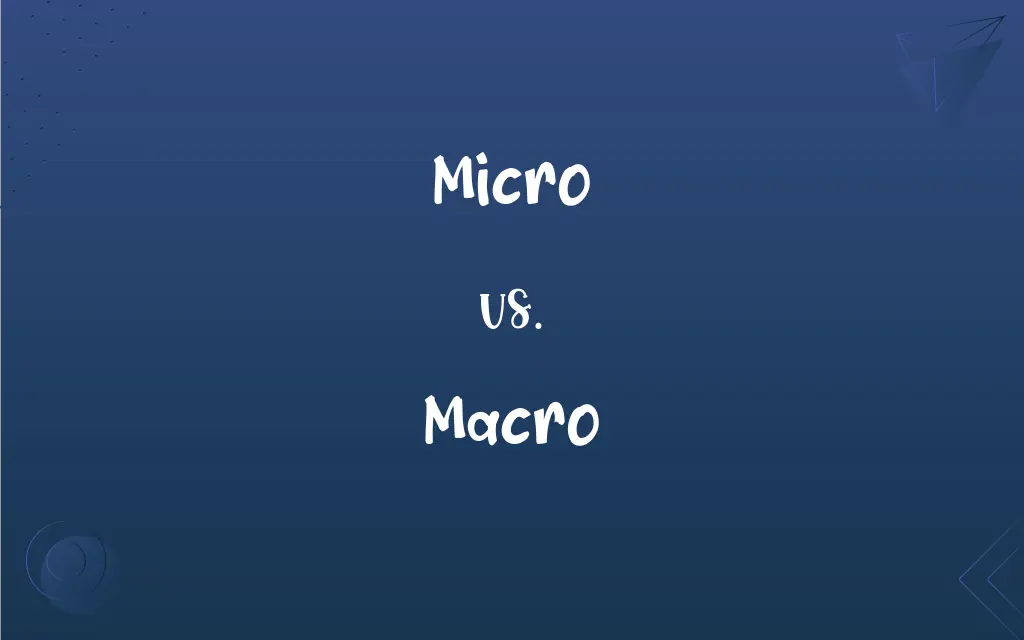Micro vs. Macro: What's the Difference?
Edited by Aimie Carlson || By Harlon Moss || Published on November 18, 2023
Micro pertains to small-scale, detailed aspects; macro refers to large-scale, broader perspectives.

Key Differences
Micro denotes something small, detailed, or on a minute scale. It often refers to fine details or individual elements of a larger whole. Macro, in contrast, signifies something large, broad, or encompassing a wide scope. It relates to overarching themes or the big picture.
In various disciplines, micro focuses on specific, individual components. For example, microeconomics examines individual markets and consumer behavior. Conversely, macro deals with aggregate, collective elements, such as macroeconomics studying national economies and overall market trends.
Micro implies close-up examination or analysis. It signifies attention to minutiae and intricacies. Macro, on the other hand, implies stepping back for a wider view. It signifies understanding systems, patterns, or phenomena at a comprehensive level.
In photography, micro refers to close-up shots capturing intricate details, often used for small objects or textures. Macro, in photographic terms, means capturing a larger scene or landscape, emphasizing the broader composition rather than intricate details.
Micro and macro can also denote levels of analysis or approach. Micro-level analysis delves into individual cases or specific instances, while macro-level analysis looks at broader patterns, trends, or generalizations.
ADVERTISEMENT
Comparison Chart
Scale
Small-scale
Large-scale
Focus
Detailed, individual components
Broad, collective elements
Perspective
Close-up, in-depth
Wide, comprehensive
Example in Economy
Individual markets, consumer behavior
National economies, overall market trends
Use in Photography
Close-up shots, intricate details
Larger scenes, broader composition
ADVERTISEMENT
Micro and Macro Definitions
Micro
Extremely small or minute.
The micro particles were invisible to the naked eye.
Macro
Relating to the overall or major parts of something.
The macro trends in the industry were shifting rapidly.
Micro
Involving detailed or precise consideration.
She had a micro focus on the project’s intricate details.
Macro
Large in scale or scope.
The macro analysis provided an overview of the entire system.
Micro
Pertaining to microeconomics or small-scale economic phenomena.
The study focused on micro factors affecting consumer choices.
Macro
Used to indicate a larger than usual version of something.
The artist created a macro sculpture, towering over the spectators.
Micro
Relating to or denoting a small-scale level.
The scientist conducted micro analysis of the cells.
Macro
Involving consideration of the big picture.
Her research took a macro approach to societal changes.
Micro
Used to indicate a smaller than usual version of something.
The company launched a micro version of its popular device.
Macro
Pertaining to macroeconomics or large-scale economic phenomena.
The lecture discussed macro factors influencing global markets.
Micro
Very small or microscopic.
Macro
Of great size; large.
Micro
Basic or small-scale
The economy's performance at the micro level.
Macro
Large in scope or extent; large-scale
A macro analysis of many reports.
FAQs
How is macro used in economics?
In economics, macro refers to the study of national economies and overall market trends.
What does macro mean?
Macro means large-scale or broad in scope.
Can micro and macro perspectives be combined?
Yes, combining micro and macro perspectives can provide a comprehensive understanding.
How does micro differ from macro in photography?
In photography, micro focuses on close-up details, while macro captures larger scenes.
Can something be both micro and macro?
Yes, depending on the context and perspective.
Is micro only used in science?
No, micro can be used in various fields like economics, sociology, and more.
How is micro used in biology?
In biology, micro often pertains to microscopic or cellular levels.
Can micro perspectives provide in-depth understanding?
Yes, micro perspectives often focus on depth and detail.
Are micro and macro mutually exclusive?
No, they represent different perspectives and can complement each other.
Can macro perspectives offer general insights?
Yes, macro perspectives are useful for understanding general patterns.
What does micro mean?
Micro means small-scale or detailed.
How is micro used in economics?
In economics, micro refers to the study of individual markets and consumer behavior.
Is micro always physical in nature?
No, micro can also refer to conceptual or analytical levels.
How is macro used in sociology?
In sociology, macro refers to societal, institutional, or large-scale social patterns.
Are micro and macro scales fixed?
No, what is considered micro or macro can vary based on context.
Can macro trends influence micro behaviors?
Yes, macro trends can shape or influence micro-level behaviors and decisions.
Is macro more important than micro?
Neither is inherently more important; both offer valuable perspectives.
Can micro elements affect macro systems?
Yes, micro elements can have impacts on broader macro systems.
Is macro limited to economics?
No, macro is applicable in various disciplines beyond economics.
Is macro always about size?
No, macro can also refer to scope, breadth, or level of analysis.
About Author
Written by
Harlon MossHarlon is a seasoned quality moderator and accomplished content writer for Difference Wiki. An alumnus of the prestigious University of California, he earned his degree in Computer Science. Leveraging his academic background, Harlon brings a meticulous and informed perspective to his work, ensuring content accuracy and excellence.
Edited by
Aimie CarlsonAimie Carlson, holding a master's degree in English literature, is a fervent English language enthusiast. She lends her writing talents to Difference Wiki, a prominent website that specializes in comparisons, offering readers insightful analyses that both captivate and inform.






































































